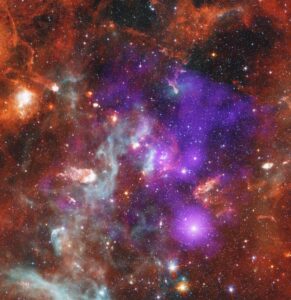A massive swirl of bright white light seemingly appeared from out of nowhere in the night sky above the Arctic last week, briefly upstaging a vibrant aurora display that spanned thousands of miles. The ethereal, galaxy-shaped light show was caused by an illuminated cloud of frozen fuel that was dumped in space by a SpaceX rocket, which released dozens of satellites into low-Earth orbit. Astronomers call this rare phenomenon a “SpaceX spiral,” and expect them to become a much more common sight in the future. Related: Eerie blue spiral in…
Read MoreHistorical incidents of viewing total eclipses near the edge of totality
Of the 15 states that will be touched by the moon’s dark umbral shadow on April 8, no state is perhaps more enthused at the prospect of hosting the total solar eclipse than New York. Indeed, this will be the first time in 99 years that the path of totality will sweep across the Empire State, and the “I Love New York” campaign, used since 1977 to promote tourism in the state of New York, is going all out to attract prospective eclipse watchers from other parts of the country to “Come for the…
Read MoreA Tranquil Sunrise
A fast boat is seen at sunrise after the landing of SpaceX Dragon Endurance spacecraft a few hours earlier in the Gulf of Mexico off the coast of Pensacola, Florida, Tuesday, March 12, 2024. The Crew-7 members returned after nearly six-months in space as part of Expedition 70 aboard the International Space Station.
Read MoreNASA, Health and Human Services Highlight Cancer Moonshot Progress
NASA Administrator Bill Nelson delivers remarks during an event with Department of Health and Human Services Secretary Xavier Becerra to highlight how the agencies are making progress toward President Joe Biden and First Lady Jill Biden’s Cancer Moonshot initiative, Thursday, March 21, 2024, in the Earth Information Center at the Mary W. Jackson NASA Headquarters building in Washington. NASA is working with agencies and researchers across the federal government to help cut the nation’s cancer death rate by at least 50% in the next 25 years, a goal of the…
Read MoreSpaceX’s Starship could fly again as soon as early May
We might not have to wait too long to see the world’s most powerful rocket take to the skies again. That vehicle, SpaceX’s 400-foot-tall (122-meter-tall) Starship, conducted its third test flight last Thursday (March 14) from the company’s Starbase launch site in South Texas. Starship notched a number of important milestones on that mission, but both of its stages ended up breaking apart while descending through Earth’s atmosphere. SpaceX is still analyzing data from the flight. The results will inform preparations for Starship’s fourth flight, which could be just around…
Read MoreChina launches satellite to support future moon missions (video)
China launched a satellite toward the moon this week to help support the country’s lunar ambitions. On Tuesday (March 19), a Long March 8 rocket took off from the Wenchang Satellite Launch Center on the southern Chinese island of Hainan carrying the Queqiao-2 satellite. The spacecraft is what’s known as a relay satellite, meaning it will help pass messages back and forth between China’s Chang’e moon spacecraft, as well as other vehicles on the lunar surface, and mission controllers on Earth. Queqiao-2 is intended for a highly elliptical orbit around…
Read MoreNASA Advanced Air Mobility Partnerships
12 min read Preparations for Next Moonwalk Simulations Underway (and Underwater) NASA is partnered with other government agencies, industry, and academia to conduct Advanced Air Mobility (AAM) research to benefit a future transportation system with routine flight of air taxis and drones. See the current partnerships below and in the map above. AerostarSioux Falls, South DakotaNASA and Aerostar are conducting collaborative evaluation of a NASA prototype simulated Upper Class E Traffic Management (ETM) system. AeroVironmentSimi Valley, CaliforniaNASA and AeroVironment are conducting research, development, testing, and evaluation of a NASA prototype…
Read More1 in 12 stars might have swallowed a planet
About one in every 12 stars may have swallowed a planet, a new study finds. Previous research had discovered that some distant stars possess unusual levels of elements, such as iron, which one would expect to make up rocky worlds such as Earth. This and other evidence suggested that stars may sometimes ingest planets, but much remained uncertain about how often that might happen. One way to uncover more about planetary ingestion is to look at two stars born at the same time. Such twins should have a virtually identical…
Read MoreThe Marshall Star for March 20, 2024
22 Min Read The Marshall Star for March 20, 2024 Marshall Technologist Talks Solar Sail Technology in Rocket Center Exhibit By Jessica Barnett Space enthusiasts at the U.S. Space & Rocket Center were treated to a special exhibit featuring technologist Les Johnson of NASA’s Marshall Space Flight Center and a look at the future of solar sail technology. NASA technologist Les Johnson, on stage, discusses how the solar sail can use solar propulsion to travel farther in space than anyone has traveled before during an exhibit held March 12 at…
Read MoreFollowing Safe Return, NASA’s SpaceX Crew-7 to Recount Space Mission
The four crew members of NASA’s SpaceX Crew-7 mission are seated inside the SpaceX Dragon spacecraft after landing in the Gulf of Mexico on March 12, 2024. Credits: NASA/Joel Kowsky After spending 199 days in space, NASA’s SpaceX Crew-7 crew members will discuss their science mission aboard the International Space Station during a news conference at 2:30 p.m. EDT Monday, March 25, at the agency’s Johnson Space Center in Houston. NASA astronaut Jasmin Moghbeli, ESA (European Space Agency) astronaut Andreas Mogensen, JAXA (Japan Aerospace Exploration Agency) astronaut Satoshi Furukawa, and…
Read More













